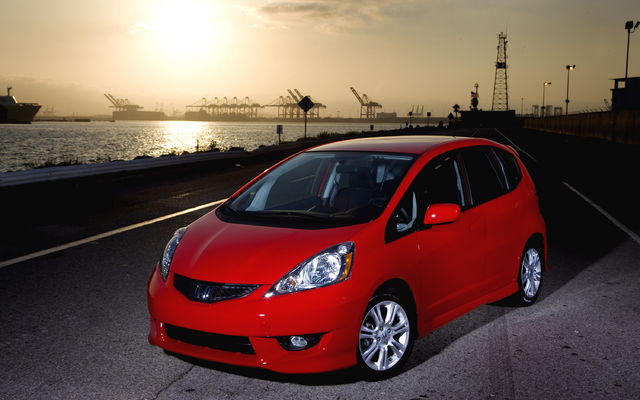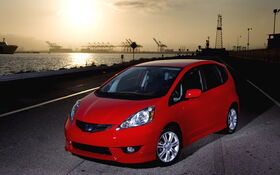2009 Honda Fit Sport: Finally, a Fit that Fits!

| Strong points |
|
|---|---|
| Weak points |
|
Last year, when I spent a week aboard the previous generation Honda Fit, I vowed never to set foot in such a vehicle again. Sure, it looked pretty nifty, and the interior was easily the most adaptable I’d encountered, but the reality of the situation was that I was about 3” too tall for it. Each day was an exercise in controlling the tremors I’d endure in my calves as my feet attempted to fold themselves flat against my shins in an effort to manipulate the nearly vertical pedals. However, barring the brush with shin splints, the car was relatively enjoyable to drive, and it wasn’t long before the Fit began to look better and better in rose-tinted retrospect. So, when I got news that a 2009 Fit Sport was available for booking, I thought I’d give the diminutive five-door another shot.
And am I ever glad I did. Upon first impression, the new Fit looks better in every way, shape, and form; literally. Although it has been described (quite accurately, I might add) as looking slightly overinflated, the bulging panels suit the big-eyed Fit, and enhance the car’s already lovably cartoonish looks. Featuring what Honda is calling a “super forward aero-forwrd design,” the new Fit sports an even larger windshield that is accompanied by larger quarter windows as well; offering the driver better forward vision. Of course, all that surgery also required moving the a-pillar further forward, and it now joins the hood almost perfectly atop the wheel-arch. Underneath, the unibody’s rigidity has been increased through a 14% increase in high-tensile steel usage, with most of that going into the revised front end. As a result, the front subframe is a full 164% more rigid with a neglible increase in weight.
But, the biggest improvement is in the interior. While is certainly won’t be confused with its more upscale Acura brethren, the Fit finally... well... fits. Although it’s still a bit of a reach to the steering wheel, I managed to adjust everything until I was the picture of comfort. The larger windshield and cab-forward design gives a fantastic view, and it felt far less claustrophobic inside. The dashboard is expectedly Honda-esque, which is to say it’s simple and easy to use, but it’s the center console that really impresses. First off, the collection of buttons that make up the stereo and HVAC controls not only look great, but are also dead easy to manipulate. Large, and with intuitive functions, they suit the Fit’s youthful market perfectly, and the blue backlighting is a nice upscale touch. And although it may sound like an inconsequential detail, the inclusion of a USB jack for iPod integration in the Sport trim package is a much-appreciated touch, as is the decision to install said jack within the upper glovebox. This meant my iPod stayed safely concealed while driving, and more importantly, while parked. And when it came time to stow other sundries about the Fit’s cabin, there was definitely no shortage of bins and cupholders. However, there was a small problem with the cupholders mounted in the center console. Stuffed below the dashboard, there wasn’t enough clearance to actually get the average fast-food sized beverage into and out of the cupholders with any sort of grace. Trust me. And on that note, it might be worth mentioning that the plastic clean up quite nicely with a liberal application of napkins. Thankfully, there’s a couple additional cupholders mounted high on the dashboard that are eminently more useful.
Of course, the famous rear seat makes a return for 2009, coined the “Magic Seat” by Honda’s trademarking department. A unique dual folding 60/40 split design, it features seatbacks that fold flush to provide a flat load floor, as well as seat bottoms that can fold upwards and fit vertically against the back to provide a cargo well in the rear footwell. For longer items, the front passenger seat can also be folded flat, providing a total of over seven feet of storage length. More importantly perhaps, the rear seat is engineered to provide comfortable, spacious seating for three. Realistically, it provides comfortable, spacious seating for two, with plenty of leg, and headroom.
Now, thoroughly impressed with the interior, it came time to discern how deserving the Fit Sport was of the latter half of its nameplate. Blessedly equipped with the five speed manual transmission, the Fit Sport also boasts 8 more horsepower from the new 1.5L four cylinder; bringing the total up to 117 horsepower. In the Sport model, automatic transmissions receive steering-wheel mounted paddle shifters, while the manual gearbox is stuffed with shorter gear ratios and a shorter shift linkage that reduces the shifter’s throw.
Turning the key, you wouldn’t know it as anything other than a standard Honda product. The same starter noises emanate from under the car, followed by the familiar rattle of the cylinders firing. However, after it settles down to a smooth idle, you’d be hard pressed to tell if the engine’s even running. Having gone through the motor to quell piston slap and engine knock, Honda’s opted to revise the piston’s crown with a wider outer rim and a more compact crown. This keeps the kinetic energy closer to the piston’s centerline, reducing its tendency to torque over within the cylinder. Furthermore, the piston skirts feature the first usage of a patterned piston coating. This improves oil retention on the skirt, and reduces friction to free up power and quiet the motor even more. And if you think all this technology doesn’t amount to much, you’d be dead wrong; many a passenger wondered if the Fit Sport was a hybrid by virtue of its dead silent nature when stopped.
Of course, all that technology also adds up to one lively motor, and its response to the drive-by-wire throttle was eager. Hustling the diminutive hatchback down the road, the 1.5L motor won’t propel the Fit up to astronomical speeds with the aplomb of a GTI, nor will it send it hurtling down the road with the ferocity of an SRT4, but the smooth engine, flawlessly geared transmission, excellent shifter and perfectly placed pedals allow one to control every facet of the Fit’s internal processes so as to best carry momentum through every twist and turn. And while the torsion beam rear suspension may not be the most technologically advanced layout, it works well with the stiffer MacStrut front end, and the package is, in a word, playful. With relatively narrow tires on a narrow track width, it’s not overly stable, but does provide the driver with plenty of feedback. Although equipped with the now-mandated electrically boosted steering, the simply proximity of the drive to the front suspension means you get a fantastic feel for the front end’s grip through the Sport-specific steering wheel (which is also known as a Honda Civic steering wheel). Even better still, the car responds to inputs just as readily as it broadcasts how much grip you’ve got left. Tap the brake pedal mid-corner and any understeer instantly becomes glorious oversteer that’s easily caught thanks to the quick steering.
Around town, the Fit Sport performs just as admirably. The relatively small motor demands little in terms of torque-holding capacity from its equally small clutch, and as such it’s pleasant to operate and never gets tiring. The good sight lines and small size help it move through traffic in a Ginsu fashion, and whilst the 1.5L four cylinder is plenty of fun to wring out, fuel mileage is still excellent. Never topping 6.0 litres per hundred kilometres, a more sedate pace rewards with even better mileage, although the difference comes down to just a few dollars per tank.
In short, fitful driving or not, the new Fit easily fits within most budgets, and thanks to significant revisions throughout, it will fit you too!











